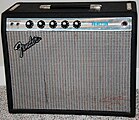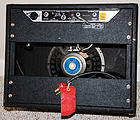128:
104:
116:
613:
17:
625:
93:
independent 25.5-watt amplifiers running in stereo mode. The USA models used
Accusonics Spring Reverb while the Mexican models used DSP Reverb. Recently, the American models made at Fender's Lake Oswego factory (branded 'LO') are becoming more sought after for their high quality and rich built-in chorus modulation.
77:
dual triode, one half of which operated a tremolo oscillator and the other half of which served as a split-load phase inverter; and two 6V6GT tubes, which were fixed-biased in Class AB push-pull configuration in the power section. In 1964, the single tone control was replaced with individual bass and
65:
in having two versus one preamp stage (6SC7 dual-triode vs 6SJ7 pentode) and added the tone control that was absent in the Champs; the 12AX7-based
Princeton models 5D2 through 5F2-A were essentially the Champ circuits 5D1 through 5F1 with a tone control and a somewhat larger output transformer. In
47:
The first
Princeton, the "Woody" (so called for its uncovered wooden cabinet), was the smallest of the original Fender line of three amplifiers, an incredibly basic 3-watt practice amp with no controls at all, not even a power switch. The first widely produced Princeton, the 1948 tweed-covered "TV
96:
In 2006, Fender revived the
Princeton name, under "Princeton Recording-Amp" (Pro-tube series) and "Princeton 650" (under Dyna-touch III series). The Princeton recording amplifier is basically a blackface Princeton with built-in overdrive, compressor and power attenuator. Fender also reissued the
92:
Fender produced a solid state
Princeton from 1988 to 2001, the Princeton Chorus. Models from 1988-1991 ("red knob") were made in USA, models from 1991-1997 ("black knob") were also made in USA, and models from 1998-2001 ("black knob") were made in Mexico. This model was notable for its two
60:
beam power tetrode necessarily in Class A operation. The amplifier had a single volume control and a simple low-pass tone control to control treble response. The
Princeton circuits up through 5C2 differed from the
551:
556:
507:
56:
dual-triode tube to provide two stages of RC-coupled voltage amplification in the preamplifier section; the power amplifier section used a single cathode-biased
502:
69:
In 1961, a new
Princeton (6G2) of fundamentally different design was introduced, which instead of being essentially an upgraded Champ was more like a junior
617:
89:, which is a heavily hot-rodded Princeton equipped with modified preamp and a Bassman transformer, allowing it a higher gain output of 60 watts.
78:
treble control knobs, and the base
Princeton was joined by the Princeton Reverb. A pull-out "boost" switch was added to the volume pot in 1978.
40:
in 1948, the
Princeton occupied the next to the bottom spot in the Fender line. Fender Princetons (as well as their sister amp the
176:
Technically this first "Princeton" had no name; it was offered in the catalog in a package with the
Princeton lap steel guitar.
53:
49:
33:
103:
66:
1956 the Princeton received a new cabinet roughly half again as tall and wide as the previous Champ-sized "small box."
534:
212:
651:
487:
656:
44:) from the early models into the 1970s models are highly valued particularly as recording amplifiers.
127:
523:
492:
461:
351:
262:
115:
629:
411:
303:
144:
86:
41:
401:
252:
229:
396:
282:
598:
386:
277:
205:
8:
436:
361:
190:
571:
561:
497:
456:
528:
451:
421:
366:
346:
272:
466:
338:
221:
29:
36:. It was introduced in 1946 and discontinued in 1979. After Fender introduced the
441:
313:
287:
247:
198:
73:. This "brownface" version used a single 7025 dual triode in the preamplifier; a
426:
391:
376:
356:
323:
645:
586:
381:
257:
70:
576:
566:
431:
371:
242:
62:
37:
593:
446:
82:
416:
328:
267:
237:
471:
149:
16:
581:
308:
185:
In fact, the circuit was nearly identical to the 1955-61 Vibrolux
318:
167:
Teagle, J. and Sprung, J.: Fender Amps: The First Fifty Years.
74:
220:
57:
81:
The Princeton is particularly famous as the basis for
643:
206:
109:Back panel of 1966 Fender Princeton amplifier
213:
199:
15:
644:
222:Fender Musical Instruments Corporation
194:
624:
13:
14:
668:
623:
612:
611:
126:
114:
102:
20:1966 Fender Princeton amplifier
557:List of Fender Guitar Finishes
179:
170:
161:
1:
155:
7:
138:
10:
673:
97:Princeton Reverb in 2008.
607:
544:
516:
480:
337:
296:
228:
145:Fender Princeton Reverb
535:Fender vibrato systems
488:American Deluxe Series
21:
652:Instrument amplifiers
19:
599:Starcaster by Fender
572:Fender Reverb Unit
562:Fender Custom Shop
22:
657:Fender amplifiers
639:
638:
524:Noiseless Pickups
493:California Series
462:Vibrosonic Reverb
352:Bandmaster Reverb
121:Princeton 1974/75
48:front," used one
664:
627:
626:
615:
614:
552:List of products
508:Signature Series
412:Princeton Reverb
263:George Fullerton
215:
208:
201:
192:
191:
186:
183:
177:
174:
168:
165:
130:
118:
106:
42:Princeton Reverb
30:guitar amplifier
26:Fender Princeton
672:
671:
667:
666:
665:
663:
662:
661:
642:
641:
640:
635:
603:
540:
512:
476:
402:Hot Rod DeVille
333:
292:
288:Roger Rossmeisl
248:Freddie Tavares
224:
219:
189:
184:
180:
175:
171:
166:
162:
158:
141:
134:
133:Back of 1974/75
131:
122:
119:
110:
107:
12:
11:
5:
670:
660:
659:
654:
637:
636:
634:
633:
621:
608:
605:
604:
602:
601:
596:
591:
590:
589:
579:
574:
569:
564:
559:
554:
548:
546:
545:Related topics
542:
541:
539:
538:
531:
526:
520:
518:
514:
513:
511:
510:
505:
500:
495:
490:
484:
482:
478:
477:
475:
474:
469:
464:
459:
454:
449:
444:
439:
434:
429:
424:
419:
414:
409:
404:
399:
397:Hot Rod Deluxe
394:
389:
384:
379:
374:
369:
364:
359:
354:
349:
343:
341:
335:
334:
332:
331:
326:
321:
316:
311:
306:
300:
298:
294:
293:
291:
290:
285:
280:
275:
270:
265:
260:
255:
250:
245:
240:
234:
232:
226:
225:
218:
217:
210:
203:
195:
188:
187:
178:
169:
159:
157:
154:
153:
152:
147:
140:
137:
136:
135:
132:
125:
123:
120:
113:
111:
108:
101:
9:
6:
4:
3:
2:
669:
658:
655:
653:
650:
649:
647:
632:
631:
622:
620:
619:
610:
609:
606:
600:
597:
595:
592:
588:
587:Gretsch Drums
585:
584:
583:
580:
578:
575:
573:
570:
568:
565:
563:
560:
558:
555:
553:
550:
549:
547:
543:
537:
536:
532:
530:
527:
525:
522:
521:
519:
515:
509:
506:
504:
503:Player Series
501:
499:
496:
494:
491:
489:
486:
485:
483:
479:
473:
470:
468:
465:
463:
460:
458:
455:
453:
450:
448:
445:
443:
440:
438:
435:
433:
430:
428:
425:
423:
420:
418:
415:
413:
410:
408:
405:
403:
400:
398:
395:
393:
390:
388:
387:Deluxe Reverb
385:
383:
380:
378:
375:
373:
370:
368:
365:
363:
360:
358:
355:
353:
350:
348:
345:
344:
342:
340:
336:
330:
327:
325:
322:
320:
317:
315:
312:
310:
307:
305:
302:
301:
299:
295:
289:
286:
284:
281:
279:
276:
274:
271:
269:
266:
264:
261:
259:
258:Forrest White
256:
254:
251:
249:
246:
244:
241:
239:
236:
235:
233:
231:
227:
223:
216:
211:
209:
204:
202:
197:
196:
193:
182:
173:
164:
160:
151:
148:
146:
143:
142:
129:
124:
117:
112:
105:
100:
99:
98:
94:
90:
88:
84:
79:
76:
72:
67:
64:
59:
55:
51:
45:
43:
39:
35:
31:
27:
18:
628:
616:
577:Rhodes piano
567:Fender Japan
533:
437:Super Reverb
406:
362:Blues Junior
283:Bill Schultz
243:Doc Kauffman
181:
172:
163:
95:
91:
80:
68:
63:Fender Champ
46:
25:
23:
594:Lace Sensor
498:Lead Series
457:Vibro Champ
278:Don Randall
273:Paul Rivera
253:Bill Carson
230:Key figures
83:Mesa Boogie
646:Categories
529:Wide Range
452:Vibrasonic
422:Pro Reverb
347:Bandmaster
339:Amplifiers
329:Heartfield
268:Dale Hyatt
238:Leo Fender
156:References
472:White Amp
467:Vibroverb
407:Princeton
150:White Amp
38:Champ Amp
618:Category
517:Hardware
442:Tremolux
139:See also
32:made by
630:Commons
582:Gretsch
427:Showman
392:Harvard
377:Concert
357:Bassman
314:Jackson
309:Charvel
481:Series
382:Deluxe
367:Bronco
324:Tacoma
319:Squier
304:Bigsby
297:Brands
87:Mark I
71:Deluxe
34:Fender
28:was a
432:Super
372:Champ
75:12AX7
447:Twin
54:6SC7
50:6SL7
24:The
417:Pro
85:'s
58:6V6
52:or
648::
214:e
207:t
200:v
Text is available under the Creative Commons Attribution-ShareAlike License. Additional terms may apply.



